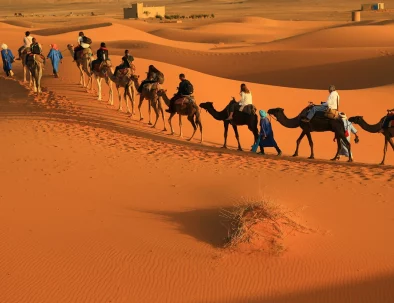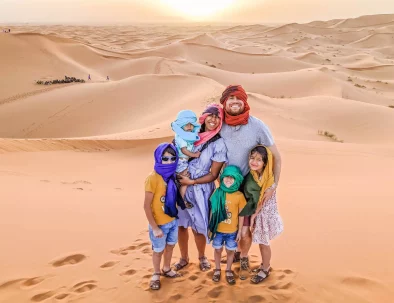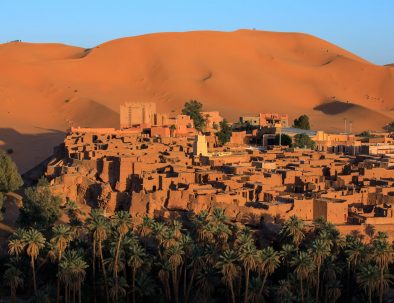Day 1: Explore Marrakech
Marrakech, also known as the “Red City,” is a significant economic hub with a vibrant medina and is known for its 1,000-year-old red sandstone city walls and buildings (old Arab quarter). Become familiar with Jemaa el-Fna, Africa’s busiest Square, and start your day by exploring the Koutoubia Mosque from the 12th century. You can escape the heat in the mosque’s gardens, surrounded by fountains and palm trees. Discover the Islamic school, Ben Youssef Madrasa, from there for a taste of architecture from the 16th century and be in awe of the exquisite details, including arabesques, Islamic calligraphy, and vibrant zellij (intricate tilework).
Observe the Fondouks, medieval traveler inns alongside historic trade routes that offered merchants lodging and supplies, as you stroll through the alleys of Marrakech. Some have been transformed into homes today, while others are sizable shopping malls and open-air workshops. Several locations south of Jemaa el-Fna may be of interest to you. Consider the 500-year-old Saadian Tombs, the expansive courtyard and sunken gardens of the El Badi Palace from the 17th century, or the elaborate woodwork and painted ceilings of the Bahia Palace from the 19th century.
Day 2: Over the High Atlas Mountains to Ouarzazate & Boumalne Dades
Depart the bustling city and travel up the High Atlas mountains in an easterly direction toward the Desert. Try to locate Mount Toubkal, the tallest peak at 13,671 feet (4,167 m). You will pass a lot of traditional mud-brick Berber villages along the way. After lunch in Taddert, tour the neighborhood’s Argan Oil Cooperative to learn how the women there extract valuable oil from the argan nut to create oil used in the food, cosmetics, and health industries. As you approach the Tizi n’Tichka pass, continue on the winding road and pause to take in the expansive view.
Continue east to Ouarzazate, a desert hub and famous filming location. Take a studio tour to find out which of your favorite movies was filmed in the nearby desert areas. A trip to the Musée du Cinema might be enjoyable for movie fans. As you progress towards Boumalne Dades along the Valley of a Thousand Kasbahs, you will pass numerous small towns and traditional farming practices in action. As you travel through fragrant Kela’a M’gouna, the “Valley of the Roses,” keep an eye out for nomads caring for their livestock. Eventually, you’ll reach Boumalne Dades, a significant city spanning the Dades River.
Day 3: Desert Towns & Camping in the Sahara
Today, you’ll continue your journey east to the Erg Chebbi sand sea near Merzouga. Stop in Tinerhir along the way to admire the river oasis surrounding the town on both sides. Impressive buttes, mesas, and plateaus can be seen in the desert landscape. You will have the chance to visit the Todra Gorge nearby, a 984-foot (300-meter) deep ravine carved out by the Todra River. Continue to Erfoud, a town in the Desert. Visit a craft shop in this region known for its figs and fossils to see how the fossil-rich rocks are expertly crafted into practical and decorative items.
Visit the livestock auction and “donkey parking lot” in the market town of Rissani as you get closer to Merzouga, the settlement closest to the Sahara. As soon as you leave Rissani, you will begin to notice the beginnings of the enormous sand sea of Erg Chebbi looming in the distance. Once you arrive in Merzouga, change up and board your camel to start the trek across the dunes to your Bedouin-style camp. Take a short hike to the top of a nearby dune to observe the sun setting, then relax with a warm meal while listening to traditional music by the fire.
Day 4: Date Palms, Alnif, & Aït Benhaddou Kasbah
Get up early to see a sunrise over the Sahara before continuing your exploration of the Desert by renting a sandboard, going on an Erg Shibi tour that circles the dunes, or taking a quad ATV tour. Travel to Khemliya in the south to discover this authentic Saharan village. You will have another opportunity to visit Maison Tuareg in Rissani, a shop that sells ethnic carpets, jewelry, and leather goods. Afterward, proceed through acacia forests with their umbrella-shaped trees to reach Alnif for lunch. Continue driving through the Draa Valley, covered in date palmeries, where you can buy a box of dates for the trip.
Visit the medieval Aat Benhaddou in the west. Morocco’s most well-known Kasbah (fort or fortification) is At Benhaddou, a protected UNESCO site. It once occupied a key spot along the trans-Saharan trade route connecting Marrakech, Ouarzazate, and the Southern Desert. After the daytime crowds have left, spend the night in the old town and explore the deserted alleys. Enter a few kasbahs for a small entrance fee, then climb to the rooftop for lovely views. You can stop in Ouarzazate 45 minutes earlier or stay here for the night.
Day 5: Return to Marrakech
To truly experience this 11th-century fortified city, explore the constrained alleyways and passageways before the crowds fill the old Kasbah. Leave Ait Benhaddou behind and make your way back to Marrakech via the Tizi n’Tichka Pass and another trip up and over the High Atlas Mountains. As you descend the High Atlas’ north-facing slopes, you’ll notice a significant environmental change. You will soon be amidst the commotion of Marrakech after all the peace of the mountains and the Desert.
You should take things more slowly for the afternoon. In the early evening, Jemaa el-Fna comes alive with musicians, performers, snake charmers, and games. As the Square is best enjoyed in the evening, wander around the stalls and vendors and take in the show. Grab a bite at one of the many food stands, or if you prefer to observe events from a distance, pick one of the cafés close to Jemaa el-Fna and savor a meal and a cup of mint tea. Take a short walk in the evening to admire the Koutoubia Mosque’s floodlights before retiring to your lodging.
Day 6: Essaouira: Seaside Ramparts, Kitesurfing, & Fresh Seafood
After breakfast, travel to Essaouira, a laid-back beach town on the Atlantic coast. The path leads you through endemic argan forests and vast, rolling plains. When grass pasture is scarce or unavailable, you might be lucky to spot goats munching on argan fruit while grazing in the trees.
Arrive in the charming port city of Essaouira—a welcome change from chaotic Marrakech—and spend the rest of the day as you, please. Explore the UNESCO-protected medina, ride horses or learn to kitesurf, or stroll along the Skala de la Kasbah or seafront ramparts, which date back to the 18th century. European engineers installed old brass cannons that lined the interior walls and provided access to the Atlantic Ocean. Fans of Jimi Hendrix might want to take a brief taxi ride to Diabat, which is at the end of Essaouira’s beach and is where he reportedly spent some time. Take a fresh seafood meal on your way back to Essaouira.
You should take things more slowly for the afternoon. Jemaa el-Fna comes alive in the early evening with musicians, performers, snake charmers, and games. As the SquareSquare is best enjoyed in the evening, wander around the stalls and vendors and take in the show. Grab a bite at one of the many food stands, or if you prefer to observe events from a distance, pick one of the cafés close to Jemaa el-Fna and savor a meal and a cup of mint tea. Take a short walk in the evening to admire the Koutoubia Mosque’s floodlights before retiring to your lodging.
Day 7: Return to Marrakech
Essaouira is a well-liked kitesurfing destination referred to as the “Windy City” due to the strong Alizée trade winds hitting its crescent beach. Before saying goodbye and departing for Marrakech, spend the morning watching the kiteboarders or take a lesson for those feeling more daring. It is possible to stop at an Argan Oil Cooperative en route to observe how valuable and pricey oil is extracted from the nut.
Visit the Dar Di Said Museum, or the Museum of Moroccan Arts, to see displays of clothing, antiques, jewelry, and exquisitely carved Hispano-Moorish decorations made of carved cedarwood. After that, explore the intricate maze of souks (markets) hidden behind regular restaurants and stores while indulging your senses. Shop for spices, furniture, and babouche at Souk el Attarin, Souk Chouari, and Souk Smita (traditional Moroccan slippers). To see how cloth and yarn are dyed using conventional techniques, visit Souk des Teinturiers (the dyers’ souk).
Day 8: Depart Marrakech
Depending on the specifics of your flight, visit the only Almoravid structure still standing, the Koubba of the Almoravids from the 12th century, before spending some time in the Marrakech Museum. The museum, housed in the 19th-century Dar Mnebbi Palace, has a sizable collection of contemporary and historical artwork. It contains items from Moroccan Jewish, Islamic, and Berber cultures.



